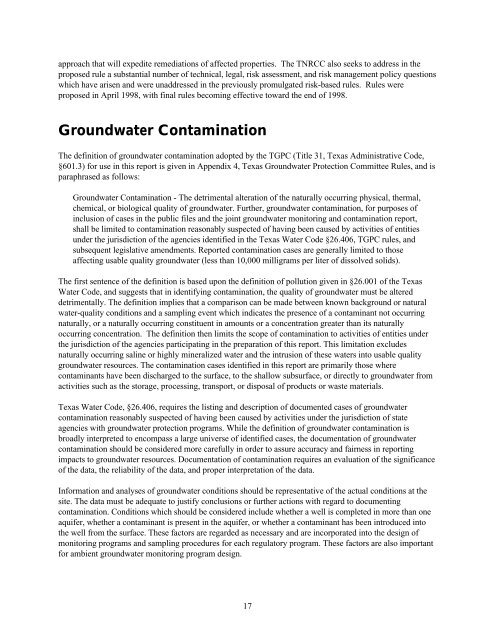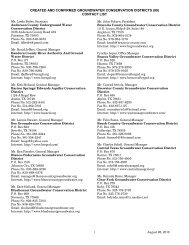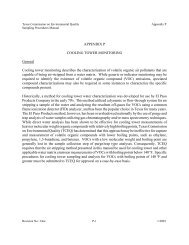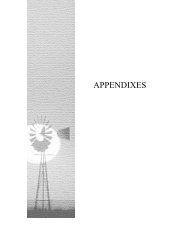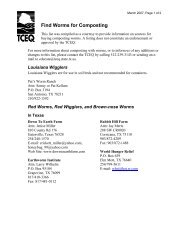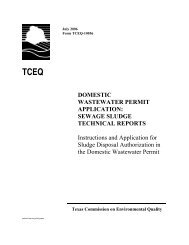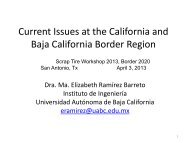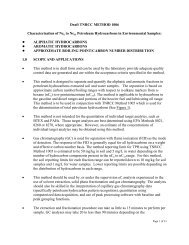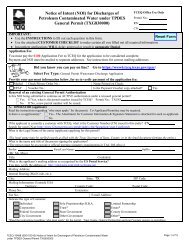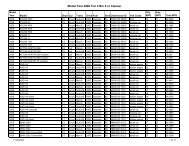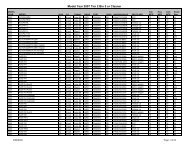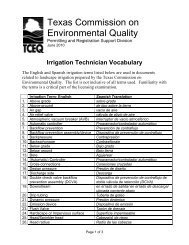joint groundwater report - Texas Commission on Environmental ...
joint groundwater report - Texas Commission on Environmental ...
joint groundwater report - Texas Commission on Environmental ...
Create successful ePaper yourself
Turn your PDF publications into a flip-book with our unique Google optimized e-Paper software.
approach that will expedite remediati<strong>on</strong>s of affected properties. The TNRCC also seeks to address in theproposed rule a substantial number of technical, legal, risk assessment, and risk management policy questi<strong>on</strong>swhich have arisen and were unaddressed in the previously promulgated risk-based rules. Rules wereproposed in April 1998, with final rules becoming effective toward the end of 1998.Groundwater C<strong>on</strong>taminati<strong>on</strong>The definiti<strong>on</strong> of <str<strong>on</strong>g>groundwater</str<strong>on</strong>g> c<strong>on</strong>taminati<strong>on</strong> adopted by the TGPC (Title 31, <str<strong>on</strong>g>Texas</str<strong>on</strong>g> Administrative Code,§601.3) for use in this <str<strong>on</strong>g>report</str<strong>on</strong>g> is given in Appendix 4, <str<strong>on</strong>g>Texas</str<strong>on</strong>g> Groundwater Protecti<strong>on</strong> Committee Rules, and isparaphrased as follows:Groundwater C<strong>on</strong>taminati<strong>on</strong> - The detrimental alterati<strong>on</strong> of the naturally occurring physical, thermal,chemical, or biological quality of <str<strong>on</strong>g>groundwater</str<strong>on</strong>g>. Further, <str<strong>on</strong>g>groundwater</str<strong>on</strong>g> c<strong>on</strong>taminati<strong>on</strong>, for purposes ofinclusi<strong>on</strong> of cases in the public files and the <str<strong>on</strong>g>joint</str<strong>on</strong>g> <str<strong>on</strong>g>groundwater</str<strong>on</strong>g> m<strong>on</strong>itoring and c<strong>on</strong>taminati<strong>on</strong> <str<strong>on</strong>g>report</str<strong>on</strong>g>,shall be limited to c<strong>on</strong>taminati<strong>on</strong> reas<strong>on</strong>ably suspected of having been caused by activities of entitiesunder the jurisdicti<strong>on</strong> of the agencies identified in the <str<strong>on</strong>g>Texas</str<strong>on</strong>g> Water Code §26.406, TGPC rules, andsubsequent legislative amendments. Reported c<strong>on</strong>taminati<strong>on</strong> cases are generally limited to thoseaffecting usable quality <str<strong>on</strong>g>groundwater</str<strong>on</strong>g> (less than 10,000 milligrams per liter of dissolved solids).The first sentence of the definiti<strong>on</strong> is based up<strong>on</strong> the definiti<strong>on</strong> of polluti<strong>on</strong> given in §26.001 of the <str<strong>on</strong>g>Texas</str<strong>on</strong>g>Water Code, and suggests that in identifying c<strong>on</strong>taminati<strong>on</strong>, the quality of <str<strong>on</strong>g>groundwater</str<strong>on</strong>g> must be altereddetrimentally. The definiti<strong>on</strong> implies that a comparis<strong>on</strong> can be made between known background or naturalwater-quality c<strong>on</strong>diti<strong>on</strong>s and a sampling event which indicates the presence of a c<strong>on</strong>taminant not occurringnaturally, or a naturally occurring c<strong>on</strong>stituent in amounts or a c<strong>on</strong>centrati<strong>on</strong> greater than its naturallyoccurring c<strong>on</strong>centrati<strong>on</strong>. The definiti<strong>on</strong> then limits the scope of c<strong>on</strong>taminati<strong>on</strong> to activities of entities underthe jurisdicti<strong>on</strong> of the agencies participating in the preparati<strong>on</strong> of this <str<strong>on</strong>g>report</str<strong>on</strong>g>. This limitati<strong>on</strong> excludesnaturally occurring saline or highly mineralized water and the intrusi<strong>on</strong> of these waters into usable quality<str<strong>on</strong>g>groundwater</str<strong>on</strong>g> resources. The c<strong>on</strong>taminati<strong>on</strong> cases identified in this <str<strong>on</strong>g>report</str<strong>on</strong>g> are primarily those wherec<strong>on</strong>taminants have been discharged to the surface, to the shallow subsurface, or directly to <str<strong>on</strong>g>groundwater</str<strong>on</strong>g> fromactivities such as the storage, processing, transport, or disposal of products or waste materials.<str<strong>on</strong>g>Texas</str<strong>on</strong>g> Water Code, §26.406, requires the listing and descripti<strong>on</strong> of documented cases of <str<strong>on</strong>g>groundwater</str<strong>on</strong>g>c<strong>on</strong>taminati<strong>on</strong> reas<strong>on</strong>ably suspected of having been caused by activities under the jurisdicti<strong>on</strong> of stateagencies with <str<strong>on</strong>g>groundwater</str<strong>on</strong>g> protecti<strong>on</strong> programs. While the definiti<strong>on</strong> of <str<strong>on</strong>g>groundwater</str<strong>on</strong>g> c<strong>on</strong>taminati<strong>on</strong> isbroadly interpreted to encompass a large universe of identified cases, the documentati<strong>on</strong> of <str<strong>on</strong>g>groundwater</str<strong>on</strong>g>c<strong>on</strong>taminati<strong>on</strong> should be c<strong>on</strong>sidered more carefully in order to assure accuracy and fairness in <str<strong>on</strong>g>report</str<strong>on</strong>g>ingimpacts to <str<strong>on</strong>g>groundwater</str<strong>on</strong>g> resources. Documentati<strong>on</strong> of c<strong>on</strong>taminati<strong>on</strong> requires an evaluati<strong>on</strong> of the significanceof the data, the reliability of the data, and proper interpretati<strong>on</strong> of the data.Informati<strong>on</strong> and analyses of <str<strong>on</strong>g>groundwater</str<strong>on</strong>g> c<strong>on</strong>diti<strong>on</strong>s should be representative of the actual c<strong>on</strong>diti<strong>on</strong>s at thesite. The data must be adequate to justify c<strong>on</strong>clusi<strong>on</strong>s or further acti<strong>on</strong>s with regard to documentingc<strong>on</strong>taminati<strong>on</strong>. C<strong>on</strong>diti<strong>on</strong>s which should be c<strong>on</strong>sidered include whether a well is completed in more than <strong>on</strong>eaquifer, whether a c<strong>on</strong>taminant is present in the aquifer, or whether a c<strong>on</strong>taminant has been introduced intothe well from the surface. These factors are regarded as necessary and are incorporated into the design ofm<strong>on</strong>itoring programs and sampling procedures for each regulatory program. These factors are also importantfor ambient <str<strong>on</strong>g>groundwater</str<strong>on</strong>g> m<strong>on</strong>itoring program design.17


